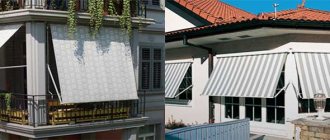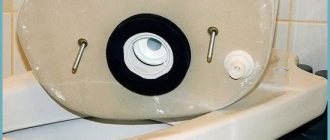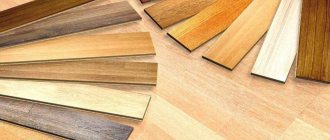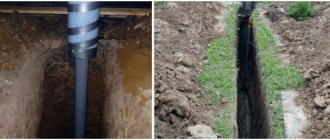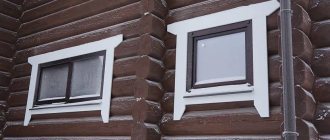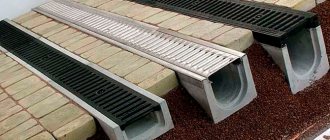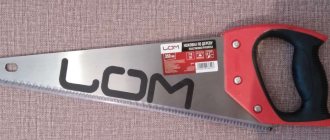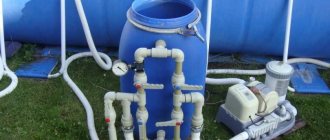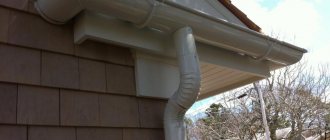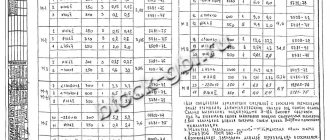In construction, mechanical engineering, agriculture, manufacturing and even in everyday life, for various reasons it is necessary to measure the humidity of gases and materials.
For these purposes, a moisture meter is used, as well as its popular subtype - a hygrometer.
The latter can be divided into many types, depending on the method of measuring humidity and various design features.
It is interesting that this is a device that is simple from a technical point of view, but extremely useful, and sometimes simply necessary from a practical point of view.
What is air humidity
Air humidity
is an indicator of the water vapor content in the air. The humidity of home air changes depending on weather conditions and human life processes.
A decrease in indoor humidity can occur due to excessive use of heating devices or air conditioning. Cooking without a hood or high-quality ventilation, drying clothes in the house, and high humidity outside lead to a high level of humidity in the apartment.
Dry indoor air can cause drying of furniture and finishing materials, wilting of plants, dry skin and mucous membranes. Dry air often leads to allergic reactions and the development of colds.
Too humid air can also damage furniture and finishing materials, contribute to the development of fungus on the walls and reduce human immunity. An unpleasant damp smell may appear in the apartment.
Content
- What is a room hygrometer?
- Hair hygrometer
- Film hygrometer
- Psychrometric hygrometer VIT-1
- Psychrometric hygrometer VIT-2
- Electronic hygrometer
- Electrolytic electronic hygrometer
- Ceramic electronic hygrometer
- Heated Electrolytic Electronic Hygrometer
- How much does a hygrometer cost?
- Where can I buy a hygrometer?
And if with temperature control everything is more or less clear - a change in the volume of the coolant with a change in temperature for mechanical devices and a change in the conductivity of a thermocouple with a change in temperature for electronic devices - then with control of relative humidity it is not so simple.
Let's look at the main types of measuring instruments designed to control the relative humidity of the environment, which are most widely used in our country.
How is air humidity measured?
Without special equipment, it is difficult to determine the relative exact level of air humidity. However, moisture concentrations that do not meet the norm can be determined by dry skin and mucous membranes or the accumulation of condensation (dew point) on windows and mirror surfaces.
Relative humidity
— the content of water vapor in the air and its interaction with air temperature.
Today there are special devices with which you can determine the balance of air humidity in a room with high accuracy.
Application area
Moisture meters are popular devices. Meteorologists have long had a need for them. Humidity, atmospheric pressure and ambient temperature are the main indicators of weather forecasting. Humidity is calculated as a percentage that demonstrates the water content in the atmosphere at actual air temperature. The maximum value is 100%.
The need for microclimate monitoring exists in many industries. Based on this, manufacturers produce devices designed for practical use in certain conditions. They ensure that the device is optimally adapted to a particular area.
Examples of tasks that a moisture meter can handle:
- Long-term storage of agricultural products requires maintaining temperature and humidity conditions. This is only possible through regular monitoring of indicators using a hygrometer. For agronomists, data on soil moisture, on which yield depends, is of paramount importance.
- Most pharmacological drugs require special storage rules. If certain humidity criteria are not met, the drugs lose their quality characteristics.
- Libraries, archives, art galleries need hygrometers. For paper media, especially ancient ones, excess moisture is destructive. Books, documents, canvases become unusable under such conditions, and the indicator is constantly measured accordingly.
- Humidity is also tested at construction sites. For example, before using wood as a building material, the degree of dryness is checked. Special contact sensors are produced to determine the moisture content of a concrete mixture.
- Furniture production also controls the humidity of raw materials, because no one wants reputational losses. Products made from wood that does not meet technological requirements will not be used for long by the consumer.
- In order to maintain product safety, production facilities in the chemical and food industries have hygrometers in their arsenal.
- To measure the humidity of gas compositions at factories producing explosive mixtures, sensor readings are mandatory.
- In everyday life, humidity plays a vital role for the human body. Its value affects the well-being of people, in particular those who are weather sensitive.
Instruments for measuring air humidity
A device for measuring air humidity is called a hygrometer
.
Hygrometer
is a device that measures indoor air humidity. If the percentage of moisture in the air is too low, various viruses can enter the body, which can significantly weaken the immune system. Thanks to the hygrometer, you can avoid discomfort and protect the mucous membranes and skin from drying out.
According to GOST, a comfortable level of relative humidity in a room in winter is 30–45%, in warm months — 30–60%.
Principle of operation
of this device is based on the physical characteristics of the materials of which it is composed. Materials, depending on the level of moisture in the air, change properties: weight, density, length and others.
There are several types of hygrometer:
- hair,
- film,
- weight,
- condensation,
- psychrometric,
- electronic.
Hair hygrometer
Hair measuring device
consists of degreased synthetic hair, pointer, spring and scale. When the amount of vapor in the air changes, the tension in the hair changes and the spring reacts to these changes by changing the position of the needle on the scale. The humidity determination range of a hair hygrometer is from 30 to 80%.
Now you can find many models of hygrometers, among which there are classic humidity meters with a temperature column, and electronic ones, the display of which immediately displays all the indicators of the optimal microclimate in the house.
Film hygrometer
The sensitive element here is a film, which also contracts or stretches when the humidity level changes. This sets the counterweight in motion, which changes the angle of the needle on the scale. The operating range is also from 30 to 80%.
Weight and condensation hygrometers
Weighing mechanical and condensation hygrometer
are distinguished by high accuracy of measuring the level of humidity in the room, since both are devices for measuring absolute air humidity. Such equipment is used only in laboratories, but not for measuring the humidity of home air.
Absolute air humidity is a measure of the amount of water vapor in the atmospheric air.
Psychrometric hygrometer
The psychrometer is based on the interaction between “dry” and “wet” thermometers. The device contains two thermometers with tinted liquids (red and blue). One of these tubes is wrapped in cotton cloth, the end of which is immersed in a reservoir of solution. The fabric becomes wet, and then the moisture begins to evaporate, thereby cooling the “wet” bulb. The lower the air humidity in the room, the lower the thermometer readings will be.
To calculate the percentage of air humidity on a psychrometer, you should find the air temperature value in the table on the device according to the thermometer readings and find the difference in values at the intersection of the indicators.
There are several types of psychrometers:
- stationary.
Includes two thermometers (dry and wet). It works according to the principle described above. The percentage of air humidity is calculated according to the table. - aspiration.
It differs from a stationary one only in the presence of a special fan, which serves to blow the thermometers with an incoming air flow, thereby speeding up the process of measuring air humidity. - remote.
This psychrometer comes in two types: manometric and electrical. Instead of mercury or alcohol thermometers, it has silicon sensors. However, as in the first two cases, one of the sensors remains dry, the second remains wet.
Electronic hygrometer (digital)
Also known as home digital weather stations. The operating principle of digital hygrometers is based on constant measurement of the air condition in the room. The device operates from the mains or a household battery. Inside the hygrometer there is a sensor that records changes in the moisture concentration in the room air.
All calculations are displayed on the device display, information is updated in real time.
Choosing a household hygrometer
To choose the right device, decide on its location and the options you need. Calculate options for installing additional radio-controlled equipment for it. Check out the technical specifications of the devices and their IP rating. When considering budget models with low measurement accuracy, choose the one that is less demanding to operate. If you want to measure more accurately, look for one with good functionality and a long-term warranty.
When purchasing, check what exactly the hygrometer measures. This can be either absolute humidity in g/m3 or relative humidity in RH. Try to measure the required indicator as accurately as possible on different models yourself. Find out what temperature range the device is designed for. Only then make a decision and carefully check the included instructions.
How to choose an air humidity meter
Modern electronic hygrometers are safe and compact. The accuracy of air humidity measurement has virtually no errors, which means this is one of the most suitable options for an apartment.
There are many models that differ in functionality, design, size, etc.
To choose a hygrometer for your apartment, you need to consider several points.
Advantages of the device
- First of all, you should pay attention to the speed of issuing results and the coefficient of error of readings;
- hygrometers can combine several devices at once: thermometer, clock, alarm clock, dew point meter, calendar, barometer, atmospheric pressure level, have voice guidance and other capabilities. If a humidity meter performs several functions at the same time, it is called a stationary home weather station;
- some modern hygrometer models have a Wi-Fi module for displaying information about the weather in the region;
- There are also remote models that can easily be moved from room to room or even outside to measure air humidity.
Humidity range and heating threshold
The range of air humidity depends on the purpose of the room. Eg:
- in the bedroom and living room these figures can vary from 20 to 80%;
- in the kitchen, near the balcony and in the pantry - from 10 to 90%;
- In the bathroom, the humidity level can reach 100%, especially after taking a bath or shower.
The wider the range of operating values of a device, the higher its price. Before purchasing a hygrometer, you should consider where it will be located, and hence choose the operating range.
The heating threshold is important for devices installed in a bathhouse or sauna. In this case, the operating temperature should not be lower than 120 °C.
Measurement accuracy
This indicator is also important, but there are no devices with large discrepancies in readings on the Russian market, and maximum accuracy with minimal errors is needed only for maintenance, for example, a home wine library.
Labeling requirements
The moisture meter according to GOST 26828 has a marking that informs:
- about the manufacturer's trademark;
- about the designation of the hygrometer;
- about the serial number;
- about the release date;
- about the sign of the State Register.
There are seals on moisture meters if they have passed transmission and reception tests.
How to maintain relative humidity in your home
We have already decided how to measure the humidity level in the room; now we just need to figure out how to restore the optimal humidity level.
If the humidity is low
- Ventilate the room.
However, this method cannot always significantly improve the state of the home microclimate, since in the summer the street air can be dry.
Also, when ventilating in the traditional way, dangerous microbes, allergens, dust, harmful gases and unpleasant odors can enter the apartment. But if you keep the windows constantly closed, then there is a high probability of encountering another problem in maintaining the microclimate - stuffiness (high levels of carbon dioxide).
High-quality ventilation is also important when ventilating rooms. A valve can provide fresh air into the room, but it will not be enough to ventilate a room inhabited by more than one person. The air passing through the supply and exhaust valve is not heated and not cleaned.
A breather will help you easily deal with the stuffiness and not let dangerous “guests” from the street into your house. This is a supply ventilation device that takes air from the street, heats it, cleans it and supplies it to the room.
- Regularly wet clean
rooms. - Install an aquarium at home.
Keeping fish in an aquarium at home can also affect air humidity. But remember that you need to take care of the fish and keep the aquarium clean. - water containers
on window sills or near heating radiators . - A humidifier
is a good option for your home. This device will cope with dry home air, improve the microclimate and prevent the development of respiratory diseases. - Climate control equipment (air conditioner, breather, air purifier, Danfoss Eco thermostat)
complete with a MagicAir base station will help not only track the microclimate conditions in the house, but also maintain optimal performance.
The base station collects information from room air about temperature, humidity and carbon dioxide concentration. All indicators are displayed on the smartphone screen in the MagicAir application.
Verification. GOST standards
Verification methods are regulated by GOSTs:
- 8.472-2013;
- 8.547-86;
- R 8.881-2015;
- 8.519-84;
- R 8.781-2012.
Technical specifications, requirements for coulometric type hygrometers in accordance with GOST R 8.758-2011.
GOST standards for test methods and general technical requirements:
- 21196-75;
- 29027-91.
Every year, hygrometers included in the State Register of SI and used in GROEI are verified without fail. Moreover, verification is carried out by bodies with special accreditation.
Each mechanical model should be calibrated (adjusted to the humidity of the environment with a known level) with a screw, usually included in the kit.
The quality of hygrometers is guaranteed by certificates of approval of the type of measurement system.
Summing up
Regardless of the principle of operation of a hygrometer, with high reliability it will become an indispensable assistant:
- At home;
- In industry, if it is necessary to maintain humidity at a given level during the production process;
- In animal husbandry and crop production;
- For precise medical and other laboratory tests;
- In warehouses;
- In museums and storage facilities of other things that are susceptible to the negative effects of moisture;
- In other areas of human life.
You can buy a hygrometer on our website by going to the Related Products category.
| Wiktionary has an article "[[wikt:Hygrometer|]]" |
Hygrometer
(Greek ὑγρός “liquid” + μετρέω “I measure”) is a measuring device designed to determine the humidity of air and other gases.
There are several classes of hygrometers, the operation of which is based on different principles (gravity, hair, conductometric, condensation and others).
They are used in microclimate systems, humidity control in industrial, warehouse and domestic premises, control of the composition of protective atmospheres, etc.
We make a psychrometer with our own hands
For many, store-bought options are either inconvenient or cost too much. Therefore, some owners prefer to make the devices themselves. Is it possible? If you have special materials and basic knowledge, it is possible to make a psychrometer yourself and at home.
First you need to decide what you need for this.
Materials and instructions for creation
Manufacturing the device will require:
- standard alcohol thermometer – 2 pcs.;
- wooden slats of different sizes - 2 pcs.;
- self-tapping screws – 4 pcs.;
- cambric (fabric) – a piece of 2x2 cm is enough;
- water container;
- distilled water or antifreeze (in the volume of the container);
- PVA glue;
- screwdriver;
- pliers;
- hacksaw for wood.
This is what the future design looks like
To begin with, take the largest rail. From it you need to cut a piece measuring 5x12 cm. In the future, it will become a stand for the device. The thickness does not matter, but it is not recommended to take plywood less than 5 mm.
To complete the central part of the device, you will need another rail, which will later become a stand. Its height should correspond to the length of the thermometers themselves. Therefore, the unnecessary part of the plywood is cut off with a hacksaw.
A traverse is installed on the finished rack
It is important that it is mounted at a right angle. Using screws, the thermometers themselves are attached directly to the traverse. The alcohol-containing ends should be directed towards the stand
The alcohol-containing ends should be directed towards the stand.
One of them is wrapped with a pre-cut piece of cambric fabric. The fabric should be applied to the thermometer with maximum density. About 1 cm of cambric is left hanging, since in the future it will serve as a connection between the thermometer and the container with liquid.
The finished tripod with thermometers attached to it is mounted to the stand. The easiest way to do this is to cut a hole in the middle of the plywood stand, equal in area to the stand itself. To keep the structure in place, it is fastened with PVA glue. Place a container of water under the thermometer with cambric.
Do-it-yourself psychrometer for incubator is ready!
How to use
You need to use it according to the following instructions:
the container is filled with liquid (antifreeze); the finished structure is placed in an incubator. It is best to place a homemade psychrometer close to the walls, since in the middle the liquid under the influence of light will quickly evaporate and distort the data
It is also important to take into account that the apparatus must be visible when the incubator is closed; After 15-20 minutes you can already take the first readings. The results obtained are substituted into the table for determining relative humidity in an incubator using a psychrometer:
The results obtained are substituted into the table for determining relative humidity in an incubator using a psychrometer:
Table of values for psychrometer
